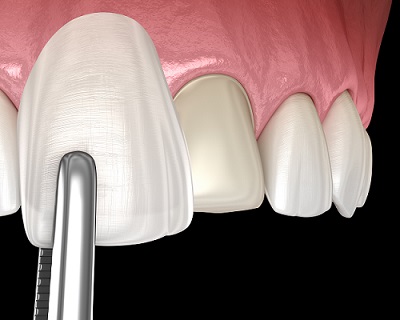Porcelain veneers are one of the most versatile and reliable tools in modern cosmetic dentistry. For patients in New Jersey veneers are a minimally invasive, long-lasting option that improves smiles without surgery or orthodontic treatments.
They can correct a huge variety of dental issues, from minor chips to worn enamel. The results are natural looking, and often part of comprehensive smile makeovers that restore balance and harmony to the face.
Fixing these issues isn’t just about aesthetics. It can improve your confidence, make speaking and smiling more comfortable, and help protect teeth from further damage. New Jersey veneers provide a functional, long-term tooth restoration solution for your appearance and oral health.
What Are Veneers and How Do They Work?
Veneers are thin, custom-crafted shells bonded to the front of your teeth to improve their appearance. They’re usually made of porcelain or ceramic, and can address stains, chips, gaps, and misalignment while preserving most of your natural tooth structure.
Veneers blend with your existing teeth and only need minimal enamel removal. New Jersey veneers offer the ideal combination of strength, translucency, and aesthetic appeal.
Dentists usually use a detailed multi-step process that maximizes both appearance and function.
Here’s what that process normally looks like:
Initial Consultation and Digital Evaluation
Your dentist will assess your smile goals, tooth structure, and oral health. Digital impressions, x-rays, and smile simulation tools may be used.
Mock-Up or Prototype Phase
Temporary resin mock-ups are created so you can preview and approve your future smile. You’ll have the opportunity to request changes before the real work begins.
Tooth Preparation
A thin layer of enamel (usually 0.3 to 1.0 mm) is gently removed from the front surface of each treated tooth to make space for the veneer.
Final Impressions
Custom molds are taken after shaping to guide the creation of the veneers in a dental lab.
Veneer Fabrication
Veneers are crafted from high-quality ceramic materials. These are matched to the shade, size, and shape best suited for your face and bite.
Try-In and Patient Approval
You’ll get to try on the veneers before permanent bonding. Minor adjustments can be made for a better fit.
Bonding and Cementation
Each veneer is bonded to the tooth with a specialized resin cement, then cured with a light to create a durable seal.
Final Polishing and Follow-Up
Veneers are polished and bite alignment is checked. Patients are given hygiene instructions and usually return for follow-up in a few weeks.
This process helps ensure that each veneer looks natural, fits comfortably, and lasts for many years.
By bonding seamlessly to the front of your teeth, veneers restore shape, color, and alignment. That makes them a powerful solution for a range of cosmetic concerns. The veneer placement process is designed to correct visible flaws while preserving your natural tooth structure.
What Dental Issues Do Veneers Correct?
Porcelain veneers are best known for their cosmetic benefits, but they also protect weakened teeth and improve bite function. Here are some of the most common problems New Jersey veneers can fix:
Can Veneers Fix Discolored or Stained Teeth?
Yes, veneers are highly effective at covering deep stains and discoloration that don’t respond to traditional whitening methods.
Veneers mask internal discoloration caused by trauma, medications, or fluorosis. They’re also stain-resistant, so they can be a big help with dull or yellowing enamel.
Studies have shown that long-term color stability is much better in veneers than in natural teeth, especially when light-cured resin cements and high-translucency ceramics are used.
Veneers fix discolored teeth by covering the visible surface with a custom-shaded ceramic shell. Veneers physically block out the underlying stain and replace it with a consistent, natural-looking color.
Your dentist can customize the veneer’s opacity, translucency, and hue to match surrounding teeth or brighten your entire smile. This tooth restoration approach provides lasting results that won’t fade over time.
Can Veneers Fix Chipped or Cracked Teeth?
Veneers can restore the shape and function of teeth with minor chips or cracks, protecting them from further damage and improving aesthetics.
Small chips, craze lines, or worn edges can make teeth look aged and unhealthy. Veneers restore the tooth’s original contour while adding protection.
In a clinical review, fractures were the most common complication. But, they can be prevented with the right selections and materials. Patients with strong enamel and minimal bite stress had better long-term outcomes.
Veneers correct chips and cracks by replacing the damaged part of the tooth’s front surface with a smooth, custom-fabricated shell. The veneer is bonded securely to the enamel, covering imperfections while reinforcing the structure underneath.
This improves appearance and prevents future breakage by absorbing bite pressure more evenly. This cosmetic dentistry solution protects and enhances your teeth’s look.
Can Veneers Fix Gaps, Uneven Teeth, or Mild Misalignment?
Yes, veneers can close small gaps, correct uneven teeth, and improve the appearance of mild misalignment.
For patients who want a straighter smile without braces or aligners, veneers offer a fast, cosmetic solution. Veneers can reshape teeth to close gaps, correct minor rotations, and realign the smile.
One published case study showed excellent results using veneers for anterior crowding when the patient declined orthodontic treatment. Follow-ups showed no complications after three years.
Veneers work by altering the visible shape and width of each tooth to create a more uniform alignment. Your dentist can build out narrower teeth to eliminate small gaps or adjust contours to make crooked teeth look straight.
Because the correction is cosmetic, veneers are ideal for patients with minor irregularities who want immediate, non-orthodontic results. This smile makeover approach delivers instant transformation without lengthy treatment times.
Can Veneers Restore Worn or Shortened Teeth?
Veneers can restore worn, flat, or shortened teeth by adding length and contour, improving both function and appearance.
Age, bruxism, and acid erosion can wear down enamel, making teeth look flat or stubby. Veneers rebuild the correct proportions and restore lost vertical dimension. Those go a long way in improving facial balance and bite functionality.
Veneers bonded to enamel were found to have higher fracture resistance compared to those bonded to dentin.
Veneers restore worn teeth by placing a durable porcelain layer over the damaged surface. That makes the tooth look longer and reinforces its structure. Upper and lower teeth meet better when biting and pressure is distributed more evenly.
Often, restoring proper tooth proportions with veneers can also reduce jaw discomfort and premature enamel wear. This comprehensive tooth restoration method addresses both functional and aesthetic concerns.
What Types of Problems Can’t Veneers Fix?
Veneers can’t fix severe misalignment, large tooth fractures, or significant decay. These conditions often need orthodontics, crowns, or implants.
While versatile, veneers are best for cosmetic and structural issues that affect the front or visible part of the teeth. They are not suitable for teeth that are extensively decayed, restored, or cracked.
Cases involving more than 50% dentin exposure also increase the risk of debonding.
This is because veneers rely on a strong foundation of healthy enamel to bond successfully and function long-term. When tooth damage goes beyond the enamel layer, veneers won’t offer enough support.
In those cases, restorative options like crowns or orthodontic treatment are better choices to protect the tooth. Your cosmetic dentistry provider can recommend the most appropriate treatment based on your specific needs.
How Long Do Veneers Last?
Porcelain veneers usually last 10 to 15 years with proper care. Up to 95% remain functional after 10 years, and 85% are still functional after 15 years.
Longevity depends on factors like enamel preservation, bonding technique, oral hygiene, and lifestyle habits. According to long-term clinical studies, veneers have an outstanding survival rate. Placing them on enamel-rich surfaces and maintaining good oral care helps them last longer.
Their durability comes from the high-strength ceramics used and the secure bond between the veneer and tooth enamel. When placed by an experienced dentist using proper techniques and materials, veneers are highly resistant to wear, staining, and fracture.
Good home care, regular checkups, and protective measures like nightguards all help extend their lifespan. This makes veneers an excellent long-term investment for your smile makeover goals.
Are Veneers Right for You?
If you have healthy teeth and gums and want to fix cosmetic flaws like chips, discoloration, or minor gaps, you may be a good candidate for veneers.
Ideal candidates have strong enamel, good oral hygiene, and realistic expectations. Veneers work best when placed on healthy, structurally sound teeth.
Your dentist will check your bite, enamel condition, and smile goals during your consultation. Digital previews and mock-ups are often used to help patients visualize results before proceeding.
During the evaluation, your dentist will assess whether veneers are the best solution for your situation. If you grind your teeth, have untreated decay, or need structural support, other treatments may be recommended.
A detailed consultation helps ensure New Jersey veneers delivers long-term comfort, aesthetics, and durability.
Here’s how a dentist usually assesses veneer candidacy:
Review of Medical and Dental History
Your dentist will ask about past dental treatments, oral habits (like grinding), and any medical conditions that may affect healing or long-term outcomes.
Clinical Examination of Teeth and Gums
Teeth are examined for decay, existing restorations, cracks, and gum health. Veneers need a stable and disease-free foundation.
Enamel Thickness Evaluation
Since veneers bond best to enamel, your dentist checks that there is enough enamel on the front surfaces of your teeth.
Bite and Function Analysis
Your dentist evaluates your bite and jaw movement to identify excessive stress or interference.
Smile Design Planning
Your dentist uses photos, digital scans, or physical impressions to plan the final look. They might create mock-ups or temporary prototypes to test aesthetics and function.
Discussion of Goals and Expectations
You’ll review possible outcomes, alternative treatments, and maintenance requirements. That way, you can make sure veneers align with your long-term goals.
FAQs About New Jersey Veneers
Do veneers hurt?
No. The process is minimally invasive. Most patients experience only mild sensitivity during and after treatment.
Are veneers permanent?
Veneers are considered permanent because a small amount of enamel is removed. They usually last 10–15 years before needing replacement.
Can veneers stain?
Porcelain veneers are resistant to most types of staining. But, regular hygiene is still important.
Do veneers need special care?
New Jersey veneers need the same care as natural teeth: brushing twice daily, flossing, avoiding grinding, and seeing your dentist regularly.
What Should You Do Next?
If you’re ready to explore how New Jersey veneers can fix your smile, talk with a local cosmetic dentistry provider.
With high satisfaction rates and impressive longevity, they remain one of the most reliable options for enhancing your smile.
Whether you want to correct chips, close gaps, or brighten discoloration, veneers offer a natural-looking and durable tooth restoration solution tailored to your needs. Your smile makeover journey can begin with a simple consultation to determine if veneers are right for you.
Resources:
Alghazzawi TF. Clinical Survival Rate and Laboratory Failure of Dental Veneers: A Narrative Literature Review. Journal of Functional Biomaterials. 2024; 15(5):131. https://doi.org/10.3390/jfb15050131
https://www.genesispub.org/longevity-of-porcelain-veneers-a-comprehensive-review
Türkaslan, S., Ulusoy, K.U. Esthetic rehabilitation of crowded maxillary anterior teeth utilizing ceramic veneers: a case report. Cases Journal 2, 8329 (2009). https://doi.org/10.4076/1757-1626-2-8329




